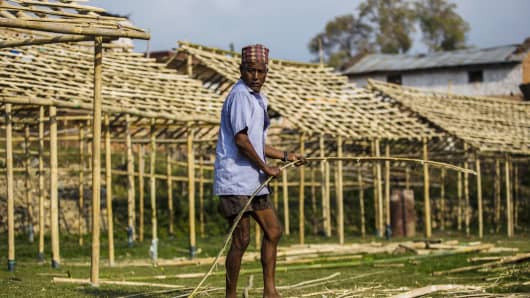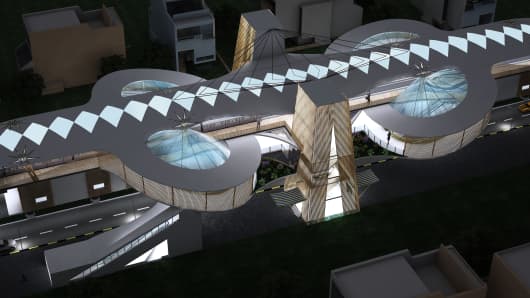Author
Nyshka Chandran | @nyshkac


 For further details log on website :
For further details log on website :
https://www.cnbc.com/2017/04/19/bamboo-in-construction-a-green-alternative-that-could-fuel-an-asian-boom.html
Nyshka Chandran | @nyshkac
Bangladesh's capital city became home to the world's first cell tower constructed entirely out of bamboo — proof that emerging Asia can simultaneously tackle two of its most pressing concerns: infrastructure investment and renewable resources.
Developed by Malaysian infrastructure services firm edotco and the Bangladesh University of Engineering, the tower took just 12 days to build, versus 28 days for a traditional steel structure, and consumed less energy to manufacture.
Bamboo boasts a low carbon footprint as it produces oxygen and captures carbon dioxide during cultivation, while sourcing for steel causes scarring to landscapes from the mining of natural resources, edotco CEO Suresh Sidhu explained. The plant takes just six months to regenerate and can be re-harvested every three years without any environmental damage, he added.
The company intends to roll out more bamboo structures as proof of concepts in other parts of Dhaka this year and will gradually expand to other markets where the firm is present, such as Myanmar and Sri Lanka.
"We hope this (tower) will inspire infrastructure companies to focus on renewable materials," Sidhu told CNBC.
Abundant throughout Asia, especially China, bamboo has long been a go-to building material for construction players drawn to its tensile strength, light weight, low cost and mass quantities. In 2007, mainland China built the world's first truck-safe bamboo road bridge, which allows a maximum load of 90 tons, according to China Daily.
One of the potential drawbacks of bamboo in construction is its susceptibility to termites, mold attacks and other adverse climate conditions, but eco-friendly treatment processes such as borax coating can help.
While bamboo design has taken off globally — in 2008, Mexico City's Nomadic Museum was the world's largest bamboo structure — it's especially relevant for developing Asia.

Prashanth Vishwanathan / Bloomberg / Getty Images
A volunteer prepares bamboo poles while building makeshift school buildings in Champi, Kathmandu Valley, Nepal, on May 29, 2015.
The region will have to spend $26 trillion on public works by 2030 to maintain economic growth, according to a recent Asian Development Bank report, and industry players believe the use of sustainable building materials for public projects is a practical long-term solution to the region's infrastructure deficit.
Going green can create a win-win situation for economic development as it benefits industrialization, expansion of trade and productivity, the United Nations told a gathering of Asia's least developed nations last month. And as Asian heavyweights such as India and China promise to reduce their carbon emissions over the next 15 years as part of the Paris Agreement, renewables will be key.
"Bamboo's use in infrastructure projects will reduce carbon emissions considerably without compromising on development," said Neelam Manjunath, principal architect at Bangalore-based Manasaram Architects and a reputed bamboo advocate.
Her firm has incorporated the crop for various public infrastructure projects throughout India, including a bus shelter and metro station in Bangalore as well as a bridge and public toilets in New Delhi.

Mansaram Architects
A mock-up of a Bangalore metro station to be built out of bamboo, designed by Manasaram Architects.
Not only is bamboo one of the world's fastest growing plants, with some species growing up to 1.2 meters in a day, it's also well-suited for urban disasters, Manjunath pointed out.
"People don't die because of disasters, but because of buildings collapsing on them. Bamboo buildings are lighter and don't cause fatalities. Because of their sheer strength, bamboo buildings are also serviceable for much longer in the face of volatile weather."
Two expats in Bali, Indonesia have taken bamboo design to a new level: Among the island's rice paddies is a school campus built out of fifty plus bamboo structures.
Co-founded by John and Cynthia Hardy, the 23-acre facility known as The Green School, is one of Asia's largest bamboo structures and its curriculum focuses on holistic learning, particularly entrepreneurship and green living.
The Green School's design can be imitated throughout the globe, Hardy stressed in a 2010 TED talk. "Is this doable in your community? We believe it is. Green School is a model we built for the world."
https://www.cnbc.com/2017/04/19/bamboo-in-construction-a-green-alternative-that-could-fuel-an-asian-boom.html





https://bambusaarundinacea.blogspot.com/2013/08/bambusa-arundinacea-vamsah-venuh-thorny.html?showComment=1649834572774#c2561350977086625707
ReplyDelete